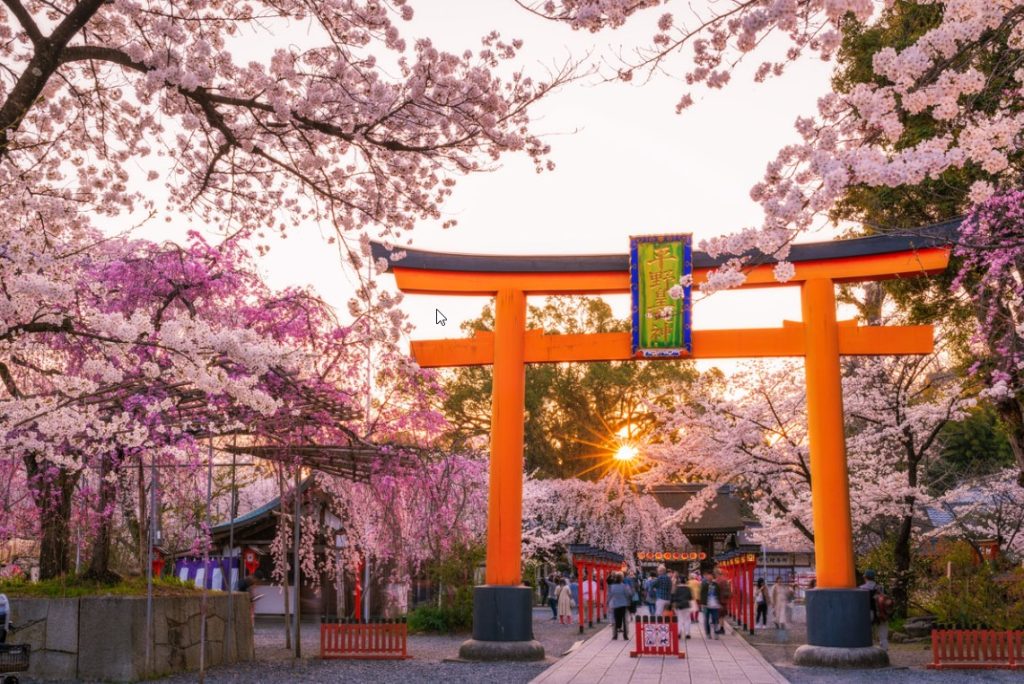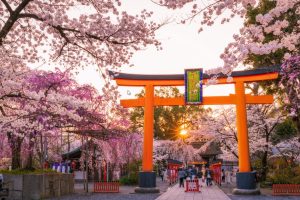
Top Things to Do in Kyoto, Japan – A Journey Through Tradition and Tranquility
Introduction – Welcome to the Timeless Soul of Japan
When people imagine Japan, they often picture the neon lights of Tokyo or the fast-paced energy of Osaka. But if you truly want to understand the heart and spirit of Japan — the quiet temples, the graceful traditions, and the breathtaking harmony between nature and humanity — you need to go to Kyoto.
Once the imperial capital of Japan for over a thousand years, Kyoto remains the country’s cultural jewel. Here, time seems to slow down. Wooden machiya houses line narrow streets, monks chant in ancient temples, and cherry blossoms drift gently through the air in spring.
This isn’t just another travel destination — Kyoto is an experience. It’s where you can sip matcha in a 400-year-old tea house, walk through golden temples, or meditate by a rock garden built centuries ago.
So, if you’re ready to fall in love with Japan’s soul, let’s take a journey through the best things to do in Kyoto, from its serene temples to its unforgettable flavors.
Chapter 1 – A City Steeped in History and Spirit
Kyoto was Japan’s capital from 794 to 1868, serving as the center of culture, religion, and art for over a millennium. Even after Tokyo took over politically, Kyoto remained Japan’s spiritual home.
You can feel its history in every corner — in the sound of temple bells, the smell of incense, and the quiet politeness of its people. It’s a city where past and present live side by side.
1.1 The Ancient Heart of Japan
Kyoto was the birthplace of many Japanese traditions still alive today — tea ceremony, kaiseki cuisine, ikebana (flower arrangement), and geisha culture. Unlike many modern cities, Kyoto escaped destruction during World War II, so much of its ancient architecture still stands proudly.
1.2 The Beauty of Every Season
Kyoto is breathtaking year-round:
- Spring: Cherry blossoms (sakura) paint the city pink and white.
- Summer: Lush greenery and lively festivals fill the streets.
- Autumn: Fiery red and gold leaves blanket the temples.
- Winter: Snow turns shrines into peaceful wonderlands.
Every season brings a new reason to visit — and every visit feels completely different.
Chapter 2 – Must-See Temples and Shrines
Kyoto is home to over 1,600 Buddhist temples and 400 Shinto shrines — enough to spend a lifetime exploring. But don’t worry — here are the must-see ones that truly capture Kyoto’s soul.
2.1 Fushimi Inari Taisha – The Thousand Gates of Dreams
No trip to Kyoto is complete without walking through the famous red torii gates of Fushimi Inari Shrine. Stretching up Mount Inari, the gates create a surreal tunnel of color and silence.
The shrine honors Inari, the Shinto god of rice and prosperity. The fox statues scattered around represent Inari’s messengers — mysterious and sacred.
Tip: Go early morning or at sunset for fewer crowds and magical lighting.
2.2 Kinkaku-ji – The Golden Pavilion
Perhaps Kyoto’s most iconic temple, Kinkaku-ji is a vision of perfection. The top two floors are covered entirely in gold leaf, shimmering over a calm pond that mirrors its beauty.
Originally built as a shogun’s villa, it’s now a Zen temple that symbolizes purity and impermanence. Visiting Kinkaku-ji feels like stepping into a painting — calm, balanced, and breathtakingly beautiful.
2.3 Ginkaku-ji – The Silver Pavilion
Despite its name, Ginkaku-ji isn’t silver, but its subtle elegance and tranquil gardens make it a masterpiece of Zen aesthetics.
Take a peaceful stroll along its moss gardens and sand landscapes, where every stone seems perfectly placed.
2.4 Kiyomizu-dera – Temple on the Hills
Built on wooden stilts overlooking the city, Kiyomizu-dera offers one of the best panoramic views of Kyoto. During cherry blossom season or autumn foliage, it’s absolutely mesmerizing.
Don’t forget to try drinking from the Otowa Waterfall, believed to bring good fortune in love, longevity, and success.
2.5 Ryoan-ji – The Zen Garden of Stillness
This temple is world-famous for its rock garden — just 15 stones on white gravel, arranged to inspire meditation and reflection. It’s a place to sit quietly, clear your mind, and find meaning in simplicity.
Chapter 3 – Step Back in Time: Kyoto’s Magical Districts
Kyoto isn’t a city of skyscrapers — it’s a city of neighborhoods, each with its own soul and charm.
3.1 Gion – The World of Geishas
Gion is Kyoto’s most famous district — a living time capsule of old Japan. Wooden teahouses, lantern-lit alleys, and elegant women in kimonos glide silently through the streets.
If you’re lucky, you might spot a maiko (apprentice geisha) on her way to an evening performance.
For a true experience, book a traditional dinner with geiko (Kyoto’s term for geisha) — a glimpse into Japan’s most refined art form of dance, music, and conversation.
3.2 Higashiyama – The Old Streets of Kyoto
This area feels like stepping into another era. Cobblestone streets like Ninenzaka and Sannenzaka are lined with souvenir shops, teahouses, and crafts.
Don’t rush — the best way to enjoy Higashiyama is to wander aimlessly, camera in hand, soaking in the textures of wooden facades and the scent of matcha sweets.
3.3 Arashiyama – Nature’s Tranquil Escape
Located on the city’s western edge, Arashiyama is where Kyoto meets nature. Walk through the Bamboo Grove, where tall stalks sway gently in the wind — it feels like another world.
Cross the Togetsukyo Bridge, visit Tenryu-ji Temple, or take a boat ride on the Hozu River. If you come in autumn, the red and orange leaves create pure magic.
Chapter 4 – A Taste of Kyoto: Culinary Delights
Kyoto isn’t just beautiful — it’s delicious. The city is a foodie paradise, blending elegant tradition with comforting simplicity.
4.1 Kaiseki – The Art of Fine Dining
Kyoto is the birthplace of kaiseki, Japan’s refined multi-course meal. Every dish is a work of art, reflecting the season and the chef’s philosophy.
Expect delicate flavors, beautiful plating, and an experience that feels like poetry on a plate.
Top spots: Gion Karyo, Kikunoi, or Hyotei, which has been around for over 400 years.
4.2 Nishiki Market – Kyoto’s Kitchen
If you love street food and local snacks, Nishiki Market is heaven. You’ll find everything from grilled skewers and sushi rolls to mochi and matcha treats.
Try yuba (tofu skin), takoyaki, and matcha ice cream — simple, fresh, and authentic.
4.3 Matcha Everything
Kyoto is the capital of Japanese green tea, especially from nearby Uji. You’ll find matcha in drinks, desserts, and even soba noodles.
Visit a traditional tea house like Camellia Tea Ceremony to learn how to whisk and enjoy matcha the proper way — calm, mindful, and delicious.
Chapter 5 – Festivals, Culture, and Hidden Moments
Kyoto’s beauty shines even brighter during its many festivals and cultural events.
5.1 Gion Matsuri (July)
Kyoto’s most famous festival, held every July for over a thousand years. Giant wooden floats parade through the streets, accompanied by music, food stalls, and colorful yukatas. It’s Kyoto’s way of celebrating summer with grandeur.
5.2 Hanami (Spring)
During cherry blossom season, locals and visitors gather under blooming trees in places like Maruyama Park or along the Philosopher’s Path. Bring some bento, sake, and friends — it’s Japan’s most joyful tradition.
5.3 Autumn Momiji
In November, the temples glow with red and gold leaves. Visit Eikando Temple or Tofuku-ji for some of the most stunning autumn scenery in Japan.
Chapter 6 – Where to Stay in Kyoto
Kyoto offers a wide range of accommodations, from luxury hotels to traditional ryokans.
6.1 Luxury & Comfort
- The Ritz-Carlton Kyoto: Riverfront luxury with stunning views and fine dining.
- Hoshinoya Kyoto: A secluded riverside ryokan accessible only by boat.
6.2 Traditional Experience
Stay in a ryokan, a traditional Japanese inn. Sleep on tatami mats, wear yukata, and enjoy multi-course breakfasts. Try Gion Hatanaka or Yachiyo Ryokan.
6.3 Budget-Friendly Options
Kyoto also has many hostels and guesthouses that mix comfort with culture, like Piece Hostel Kyoto or Sakura Terrace.
Chapter 7 – Day Trips from Kyoto
One of Kyoto’s best perks is its central location — perfect for easy day trips.
7.1 Nara – The City of Friendly Deer
Just 45 minutes away, Nara is home to free-roaming deer and the massive Todaiji Temple, where the Great Buddha sits. It’s charming, peaceful, and perfect for a half-day escape.
7.2 Osaka – Food Capital of Japan
Only 30 minutes by train, Osaka offers a complete contrast to Kyoto — neon lights, street food, and endless energy. Eat your way through Dotonbori and try takoyaki or okonomiyaki.
7.3 Uji – Home of Matcha
A smaller, quieter town famous for green tea. Visit Byodo-in Temple, featured on the Japanese 10-yen coin, and enjoy the freshest matcha you’ll ever taste.
Chapter 8 – Tips for Traveling in Kyoto
8.1 Getting Around
Kyoto’s transport system is efficient:
- Bus & Subway Passes make exploring easy and affordable.
- Rent a bicycle if you love scenic rides.
- Walking is the best way to experience Kyoto’s calm rhythm.
8.2 Best Time to Visit
- Spring (March–April): Cherry blossoms everywhere.
- Autumn (October–November): Perfect weather and fall colors.
- Winter: Quiet, magical atmosphere.
- Summer: Hot but full of lively festivals.
8.3 Travel Etiquette
- Be quiet in temples and shrines — respect the peace.
- Always take off shoes when entering tatami rooms.
- Cash is still king in many small shops.
Chapter 9 – The Spirit of Kyoto: Peace, Simplicity, and Beauty
Kyoto isn’t about rushing from one sight to another. It’s about slowing down and noticing the little things — the sound of bamboo rustling, the gentle bow of a monk, the warmth of tea in your hands.
The city teaches you the Japanese philosophy of “wabi-sabi” — finding beauty in imperfection and transience.
Kyoto invites you not just to see, but to feel. And once you’ve experienced it, a part of your heart will always remain here.
Conclusion – Fall in Love with Kyoto
Kyoto is not a city you just visit — it’s a city that changes you.
You come looking for temples, food, and Instagram photos… but you leave with something deeper: a sense of peace, appreciation, and awe for life’s quiet beauty.
From the golden reflections of Kinkaku-ji to the whispered prayers of Fushimi Inari, Kyoto is where tradition and tranquility dance together.
So pack your bags, open your heart, and let Kyoto, Japan show you that sometimes, the most magical journeys are the ones that slow you down.






